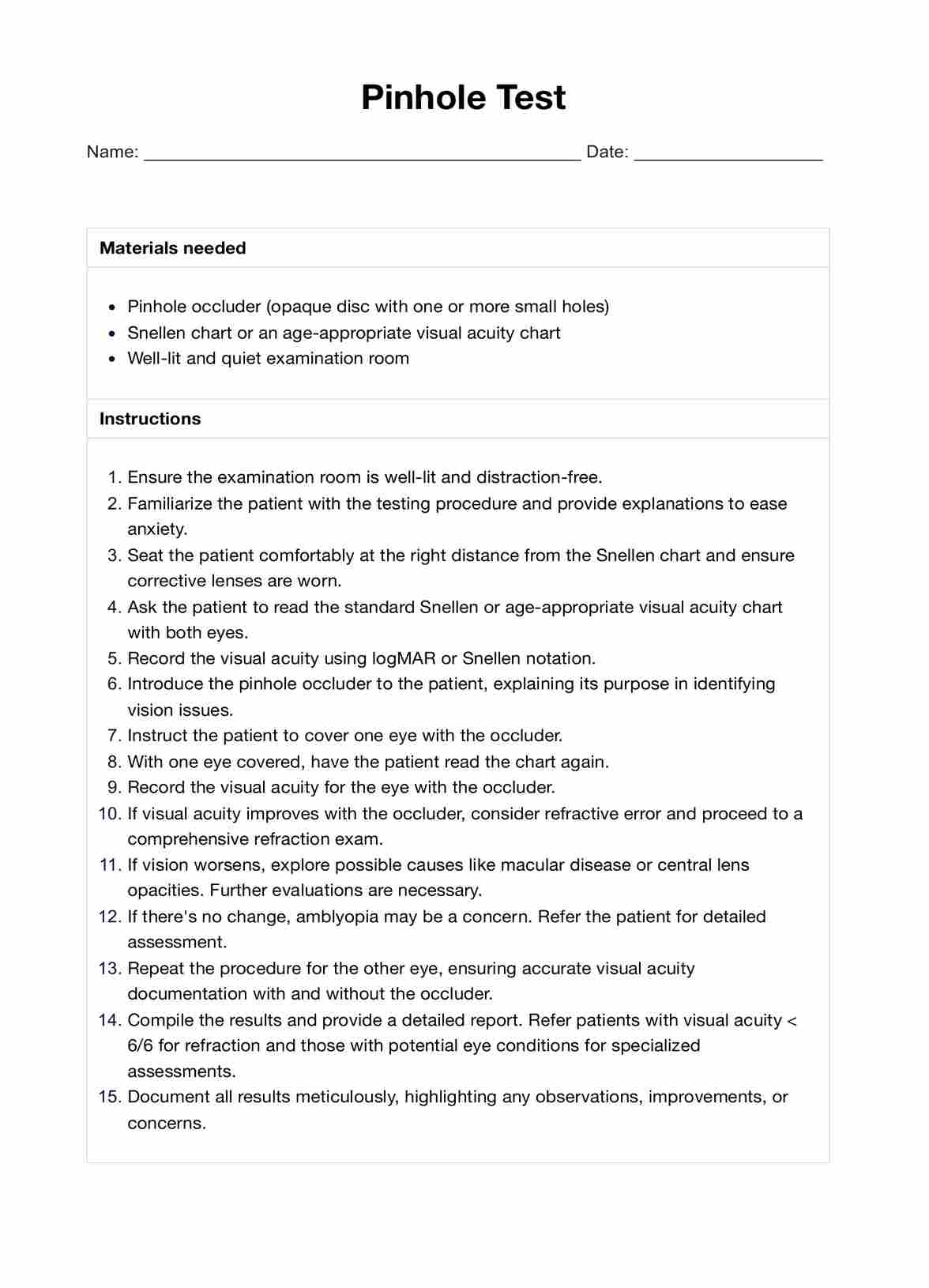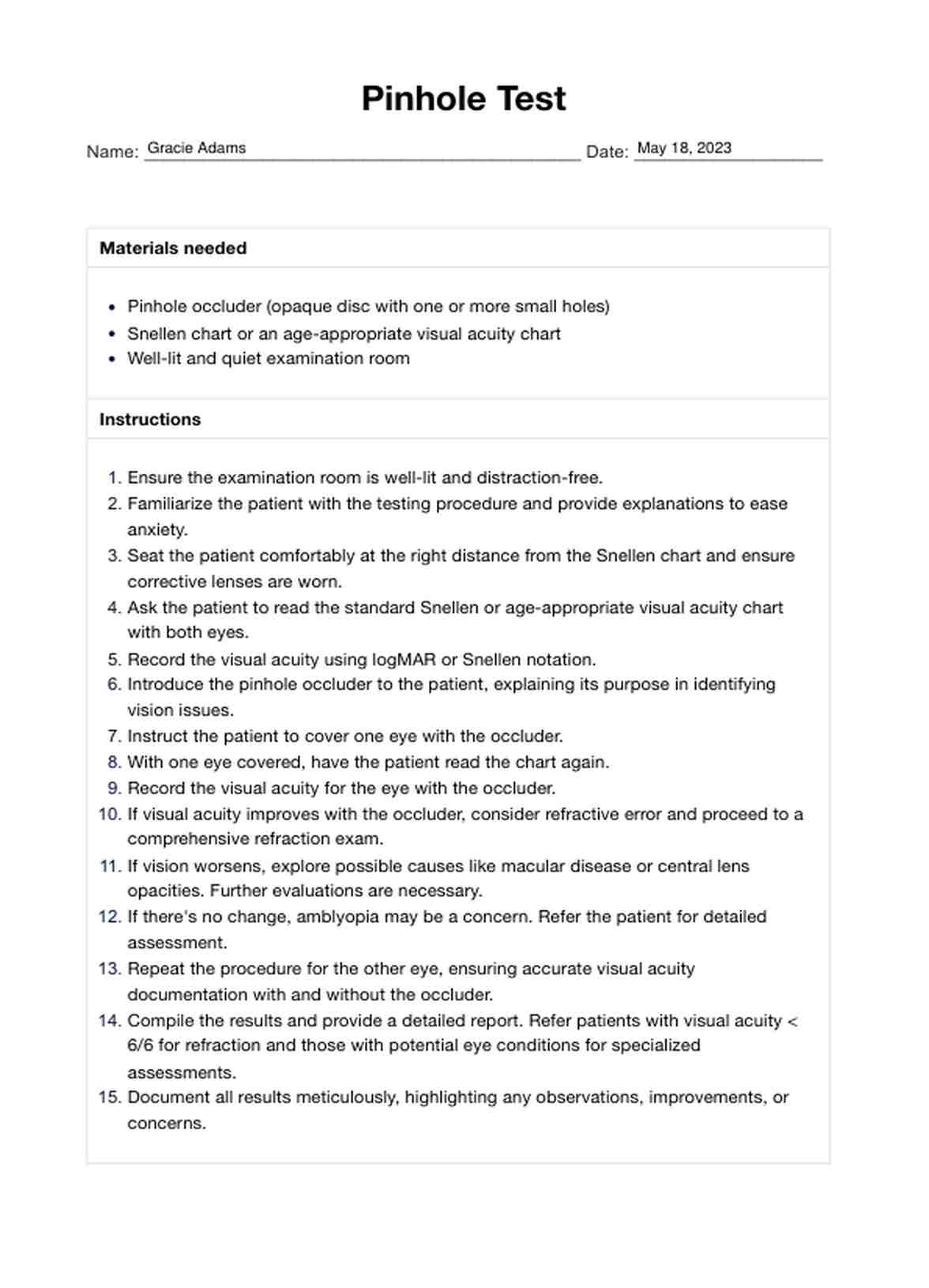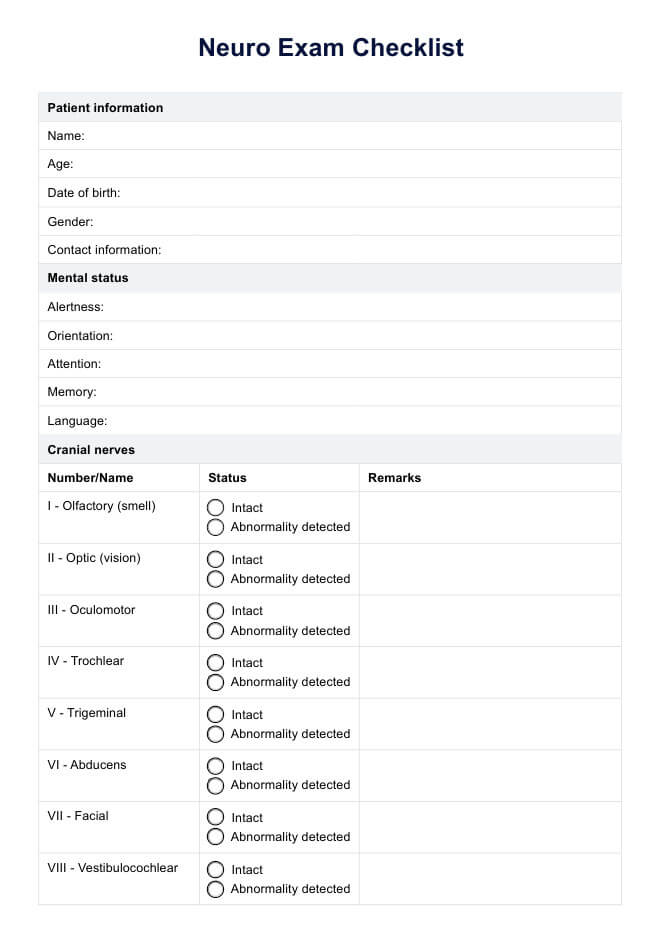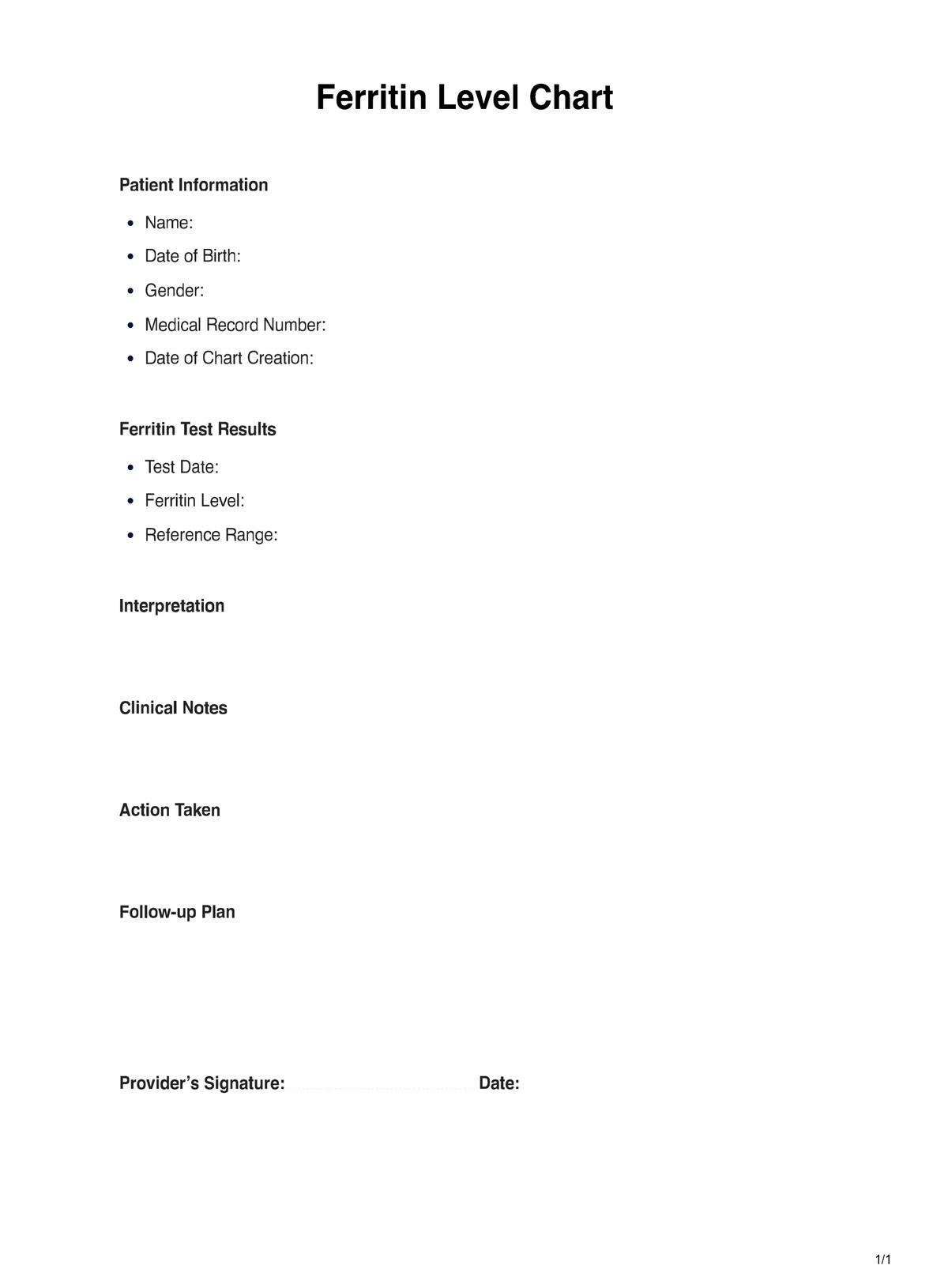Pinhole Test
Learn how to perform the Pinhole Test. Get a free PDF template and example for easy clinical documentation.


Understanding myopia
Myopia, commonly called nearsightedness, is a prevalent macular disease affecting many individuals. This condition manifests as distant objects appearing blurry while nearby objects remain clear and focused.
The root cause of myopia lies in the elongation of the eyeball or the excessive curvature of the cornea, which is the eye's transparent front covering. Due to this structural anomaly, light tends to converge in front of the retina rather than directly on it, leading to the characteristic blurriness experienced by those with myopia.
If left untreated, an uncorrected refractive error like myopia can cause progressive vision loss and contribute to other eye conditions such as glaucoma, cataracts, and retinal detachment.
Fortunately, various corrective measures are available to manage this visual impairment effectively. Options such as glasses, contact lenses, or refractive surgery can help individuals with myopia achieve clearer vision and improved quality of life.
Pinhole Test Template
Pinhole Test Example
Common causes of myopia
Myopia is a complex condition with several underlying factors contributing to its development, such as:
Genetics
Genetics plays a significant role in the occurrence of myopia. Studies have shown that children born to myopic parents are more likely to develop this condition than those with non-myopic parents (Wang, 2022). Moreover, if one parent has myopia, their child's risk increases significantly by 25%. However, if both parents have myopia, their offspring's chances of developing this condition increase by a staggering 50% (Li & Zhang, 2017).
Environmental factors
Excessive close-up work, such as reading or using electronic devices for extended periods, has been linked to the development of myopia in children and adolescents (Xiong et al., 2017). The increased amount of time spent indoors and decreased outdoor activity due to modern lifestyles have also been associated with the rising prevalence of myopia.
Research shows that outdoor activities, especially those that involve looking at distant objects, can help prevent or delay the onset of myopia (Gupta et al., 2021). This is because the eyes are less strained when looking at distant objects than near ones.
Age
Myopia often develops during childhood and may progress during adolescence before stabilizing in adulthood. It has been observed that children who develop myopia at a younger age tend to have a more severe form of the condition and are at a higher risk of developing complications such as retinal detachment or glaucoma later in life (Recko & Stahl, 2015).
Ethnicity
Studies have shown that myopia is more prevalent among certain ethnicities, particularly East Asians (Luong et al., 2020; Rudnicka et al., 2010). Genetic predisposition, cultural practices, and lifestyle choices may contribute to this trend.
Using the Pinhole Test to detect myopia
Testing visual acuity is a crucial component in determining the health of your eyes, and the Pinhole Test is a simple yet effective technique to assess potential visual acuity.
By looking through a pinhole aperture or a potential acuity meter where light passes through the eye, this test can help pinpoint issues related to refractive error. A potential acuity pinhole can illuminate those experiencing reduced vision (Hennelly, 2019).
If the clarity of sight improves significantly through the pinhole occluder, it may indicate that the reduced vision is due to refractive error rather than pathology. This is particularly useful to detect myopia, or shortsightedness, where distant objects appear blurry while close objects are seen clearly.
Healthcare professionals often use the Pinhole Test as part of a comprehensive eye examination, which can also be easily performed at home. However, patients should not rely solely on this test and should always consult a medical professional for proper diagnosis and treatment recommendations.
Moreover, it's vital to consider although it can reveal refractive errors, the test does not account for central lens opacities such as cataracts. These opacities can scatter light and cause blurring that won't be corrected through a pinhole occluder.
How to use this free Pinhole Test template
Carepatron's free Pinhole Test template is a convenient way to assess your patient's visual acuity. Here's how to use it:
Step 1: Download the template
Get a copy of the Pinhole Test using the link on this page. You may also get a copy from the Carepatron app or our resources library.
Step 2: Print or use the digital format
You can print the template or use the digital copy on your device. If you choose to print, use a high-quality printer for accurate results.
Step 3: Perform the test
Use the instructions provided in the template to perform the Pinhole Test on your patient. Remember to perform the test in a well-lit room and with the patient wearing their usual corrective lenses, if any.
Step 4: Interpret the results
If there is significant improvement in visual acuity with the pinhole occluder, it may indicate a refractive error. However, it's essential to note that this test is not a substitute for a comprehensive eye examination and should only be used as an initial screening tool.
Step 5: Refer your patient to a professional
If the results of the Pinhole Test indicate potential vision problems, it's crucial to refer your patient to an eye care specialist for further evaluation and proper diagnosis.
Benefits and limitations of the Pinhole Test
The Pinhole Test, a simple yet valuable tool, is highly advantageous in identifying refractive errors, especially myopia.
Allowing light to enter the eye through a small aperture helps determine visual acuity and differentiate between reduced vision caused by refractive errors and other potential underlying issues requiring additional examination.
The test is also convenient because it can be quickly performed at home and requires no special equipment. However, it's important to note that the Pinhole Test cannot detect central lens opacities like cataracts, requiring a more comprehensive eye exam.
Another limitation of the Pinhole Test is that it only provides a temporary solution and does not address the root cause of vision problems. Moreover, it may not accurately diagnose astigmatism, as the pinhole occluder only corrects for spherical errors. Therefore, it should not be used as a substitute for a comprehensive eye exam by an eye care professional.
Overall, while the Pinhole Test can serve as a useful screening tool, it is essential to follow up with a proper eye exam for accurate diagnosis and treatment recommendations.
References
Gupta, S., Joshi, A., Saxena, H., & Chatterjee, A. (2021). Outdoor activity and myopia progression in children: A follow-up study using mixed-effects model. Indian Journal of Ophthalmology, 69(12), 3446. https://doi.org/10.4103/ijo.ijo_3602_20
Hennelly, M. L. (2019). How to detect myopia in the eye clinic. Community Eye Health, 32(105), 15–16. https://www.ncbi.nlm.nih.gov/pmc/articles/PMC6688402/
Li, J., & Zhang, Q. (2017). Insight into the molecular genetics of myopia. Molecular Vision, 23, 1048–1080. https://www.ncbi.nlm.nih.gov/pmc/articles/PMC5757860/
Luong, T. Q., Shu, Y.-H., Modjtahedi, B. S., Fong, D. S., Choudry, N., Tanaka, Y., & Nau, C. L. (2020). Racial and ethnic differences in myopia progression in a large, diverse cohort of pediatric patients. Investigative Ophthalmology & Visual Science, 61(13), 20. https://doi.org/10.1167/iovs.61.13.20
MedlinePlus. (n.d.). Nearsightedness: MedlinePlus Genetics. National Library of Medicine. https://medlineplus.gov/genetics/condition/nearsightedness/
Recko, M., & Stahl, E. D. (2015). Childhood myopia: epidemiology, risk factors, and prevention. Missouri Medicine, 112(2), 116–121. https://www.ncbi.nlm.nih.gov/pmc/articles/PMC6170055/
Rudnicka, A. R., Owen, C. G., Nightingale, C. M., Cook, D. G., & Whincup, P. H. (2010). Ethnic differences in the prevalence of myopia and ocular biometry in 10- and 11-year-old children: The child heart and health study in England (CHASE). Investigative Opthalmology & Visual Science, 51(12), 6270. https://doi.org/10.1167/iovs.10-5528
Wang, Y. M., Lu, S. Y., Zhang, X. J., Chen, L. J., Pang, C. P., & Yam, J. C. (2022). Myopia genetics and heredity. Children (Basel), 9(3), 382. https://doi.org/10.3390/children9030382
Xiong, S., Sankaridurg, P., Naduvilath, T., Zang, J., Zou, H., Zhu, J., Lv, M., He, X., & Xu, X. (2017). Time spent in outdoor activities in relation to myopia prevention and control: A meta-analysis and systematic review. Acta Ophthalmologica, 95(6), 551–566. https://www.ncbi.nlm.nih.gov/pmc/articles/PMC5599950/
Commonly asked questions
The Pinhole Test is a simple and quick screening method used to determine whether a vision problem is caused by refractive errors such as nearsightedness, farsightedness, or astigmatism.
The Pinhole Test is mainly useful for identifying refractive errors. It does not diagnose all types of vision problems and is ineffective in detecting eye diseases like glaucoma, cataracts, or retinal disorders.
The Pinhole Test is usually performed during a comprehensive eye exam, especially if the patient is experiencing blurred vision or difficulty seeing objects at different distances. It can also be used to monitor changes in vision over time and determine the effectiveness of corrective measures like glasses or contact lenses.

















































































































